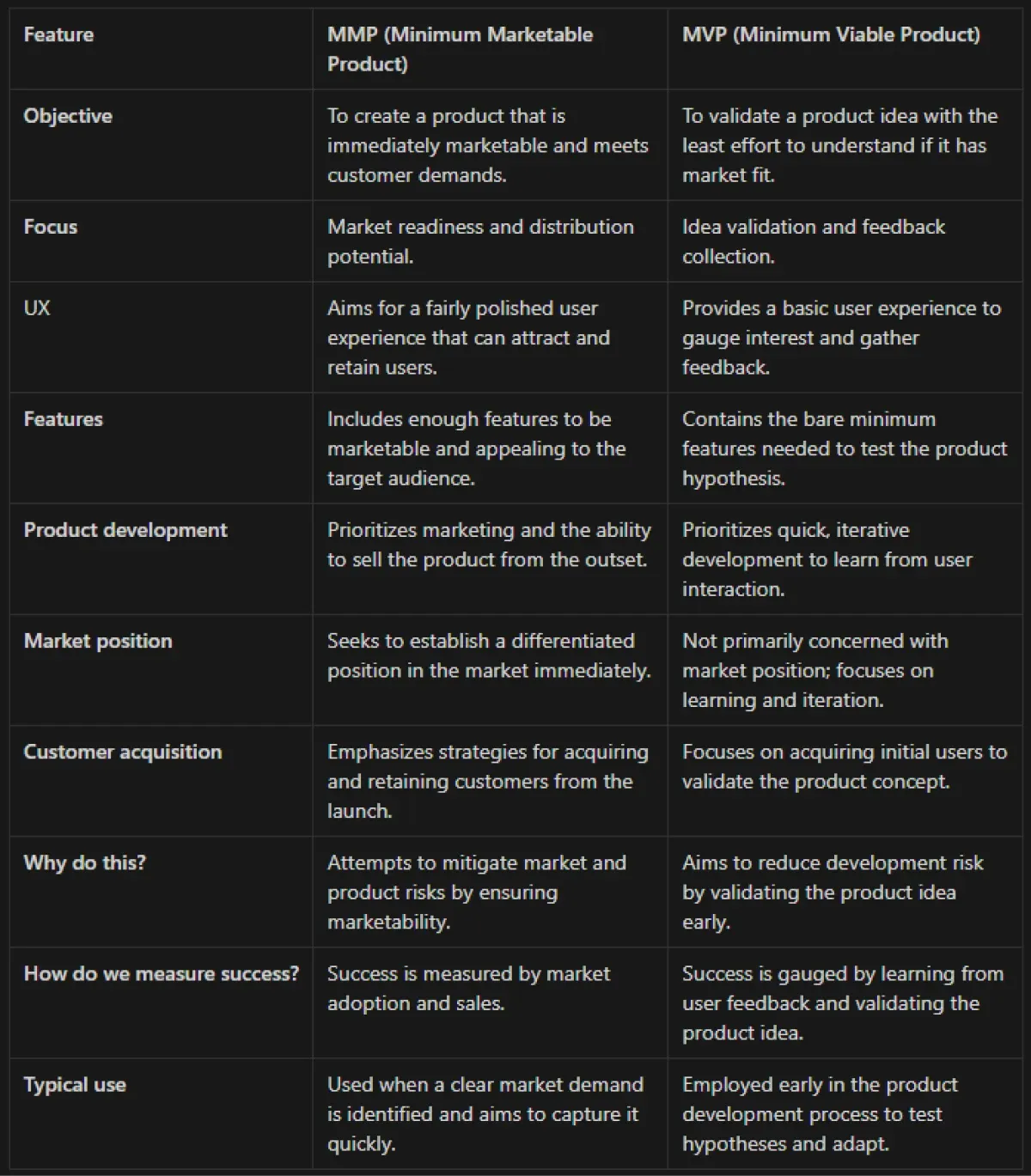Comparing a start-up MVP vs. MMP model
Most SaaS founders want to create a generational business, which means having an amazing product and user experience. But the reality is that you can't go from zero to one hundred right away when you're getting started.

Most SaaS founders want to create a generational business, which means having an amazing product and user experience. But the reality is that you can't go from zero to one hundred right away when you're getting started. So most folks go out and:
- Create a Minimum Viable Product
- Try to validate the idea
- Search for PMF.
But here’s the truth: the product you first launch probably isn’t the thing people will use most. We know this to be true: we’ve spent countless hours polishing products before the night of a ProductHunt launch, only to generate only a handful of users.
The key is to start with a Minimum Marketable Product instead. It’s a cliche at this point that “first time founders care about product; second time founders care about distribution”. It doesn’t matter how good your product is if users don’t use it because it never crossed their interesting-enough threshold.
Let’s dig into this MMP vs MVP dynamic.
The MVP approach
There's inherent friction at the beginning of building a business, so most founders have traditionally aimed for an MVP that allows them to get feedback quickly, even if it’s not very polished or, to be frank, even fully functional.
The MVP model helps create a bare-bones experience that does enough to get immediate validation from users and understand if you're on the right path. There's a reason it's been the cornerstone of startup development for a decade or two. It quickly gets you feedback, reduces engineering risk, and, in general, orients the team to get to real-life feedback ASAP.
The limitations of an MVP
And while that's all true, there are drawbacks, because you can spend a ton of time building an MVP that will never actually work in the market.
What I mean by this is that there are folks who, if you present them with a free opportunity, or if they're in your network, will test your product and maybe even suggest that they like it. But if it won't work in more traditional distribution channels at scale, it's all for naught.
If it doesn’t actually attract users, what’s the point?
Yes, it’s part of a push towards product market fit, which is the holy grail in a startup's early stage. But it can lead you down the wrong path.
Now, I'm not saying MVPs are bad in principle or in practice, but the reality is that you can spend a lot of time building something that isn't actually valuable to users.
To solve this, we can turn to a minimum marketable product approach.

Embracing the MMP
A minimum marketable product balances overhyping and overselling with the reality that you need to create a differentiated position in the market and understand whether that's actually going to work. It’s more polished, has more defined features, and also requires your team to put thought and effort into your marketing distribution plan.
When you lead with the MMP, you can distinguish the distribution potential earlier on. With an MVP, all you understand is whether the features you are building are actually helpful. If you're not able to market them or compete, it doesn’t matter.
Your product needs to pass the “will a stranger pay for this” test. Disregard if your family or friends or investors love what you’re building.
Can you market it and sell it successfully on its own value?
An MMP is trying to gauge market fit and distribution potential, not a general product hypothesis.
Comparing MMP vs MVP
Take a look at this comparison table, and notice how clearly defined each approach is.

It’s obvious that though the MMP and MVP approaches have a distinct angle to them, they both encourage a framework of speed, validation, and structure that helps founders and early-stage teams operate.
A word of advice
I asked our CEO and co-founder James about MMP vs MVP debate and how to address best the problem of going 0 → 1:
“Start with the marketing. Decide what offering you think will resonate. And then build the MVP that you think will be the minimal viable let-down to this marketing message. Remember, every sign-up is the beginning of a relationship. You don’t have to deliver fully on the marketing vision: you just have to deliver enough so that users think ‘I like where this is headed and I want to stick around.’”
When you lead with a marketing and distribution-focused approach, you reduce the risk of building something that will never actually gain traction. But, as James notes, it's also important to take that mindset into your MVP build and balance the two in a way that both validates your idea toward product-market fit and identifies potential distribution channels that will work at scale.
The next time you pursue a new business idea, consider taking a marketing-first approach with an MMP mindset.
